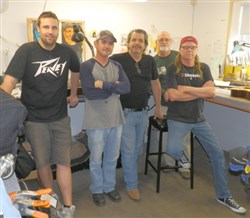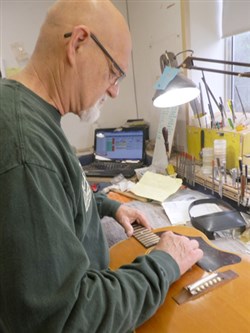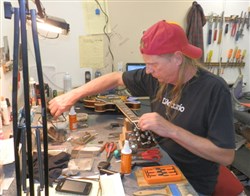VOL. 40 | NO. 13 | Friday, March 25, 2016
Famous guitars get new life in Berry Hill

Many of the music industry’s top musicians know Glaser Instruments in Berry Hill is the place to go for a for a rebuild or a tweak of their favorite stringed instrument. Joe Glaser and his crew will make them all pitch-perfect, refinished, re-fretted or whatever is needed before they go back out the door.
-- Tim Ghianni | The LedgerIt wouldn’t have surprised me to hear Vince Gill’s intricate fingerings of “For What It’s Worth” (my favorite Vince solo) or “Oklahoma Borderline” (Chet Atkins’ favorite) when I stepped inside the door of the non-descript complex that houses Joe Glaser’s guitar repair, resuscitation and rebirthing center.
Of course, I’d immediately be looking for Vince’s classic ’53 Telecaster, as well as its equally tone-rich owner with the “Go Rest High” – and I do mean high – harmonies. Course he wasn’t there. Neither was the guitar, but both spend quality time here.
When it’s time for a tune-up, Vince – perhaps the most under-appreciated guitar wizard in Nashville – brings his beloved guitars to Glaser Instruments, a white house with a maze of rooms, including a warehouse-factory extension tacked to the back.
Vince is just one of the many great guitar players of the last few decades who have found their way to Joe’s anonymous-from-the-outside place in Berry Hill, the tiny, musically inclined city – an independent urban island tucked in South Nashville that’s also home to George Jones’ grave, a pour-your-own-batter flapjacks joint and the place I buy my wild bird seed.
The Rolling Stones, Bob Dylan and John Fogerty are just a trio of the household names whose need for fret work or other repair has brought their business to this place that appears like a tiny house until you explore its voluminous guts.
Of course, there are the “regulars,” country stars like Vince – among Joe’s best friends and favorite “really funny story-tellers” – and Keith Urban, as well as some of the legendary session players from the local music factories that have captured Nashville’s increasingly eclectic sounds and exported them to the world digitally and on discs.
Musicians rightfully are particular about their instruments – I think Vince likes me OK, but I doubt he’d let me get within touching distance of the ’53 Tele – and they find comfort here, a place where they know their beloved stringed sidekicks will be serviced regally and repaired lovingly.
“I have to pinch myself,” says Joe, a young 64 (as this writer is 64, I find 64 to be a young age), who grew up in the San Francisco Bay Area with a love for rock ’n’ roll music and guitars.
In his heart, he says, he remains “this 14-year-old kid sitting in front of the stereo, the speakers on either side, listening to all of this music, all these people who shaped my life.”
He shakes his head and smiles. “Now a lot of them are my customers.”
Actually, Joe has to be coaxed into disclosing some of his clientele. He doesn’t do much name-dropping, as the musicians aren’t coming here as stars but as workmen whose tools need adjustment. It’s a matter of privacy and of comfort.
Keith Urban can play a few licks while test-driving his repaired guitars in the lobby, and he can be just plain old Keith, not the flamboyant showman with the Aussie accent and country fried rock ’n’ roll guitar licks (and that beautiful movie star wife.)
“It’s not like I’m Facebooking them or anything,” says Joe, breaking into a bright smile, when asked how close he is personally with his clientele.
The famous and infamous always have known they can relax and tell the stories of themselves and their instruments while inside the tidy confines where Joe’s “seven or eight” experts perform various specialties, from refinishing an old Gibson to working on the frets of a Telecaster to adjusting the pickup on a Strat.
Heck, one recent afternoon they were trying to figure out how one customer’s guitar case could be adjusted so it would snugly hold an uncommonly short Gretsch that the musician had fallen in love with but wanted to protect.
“They come here because they know the guys who work here for me are experts at their jobs,” explains Joe, downplaying his own importance before stopping the conversation long enough to pick up the telephone and joke about frets and scuba diving – his outside-work passion – briefly.
The whirr and grind of metalworking machinery often drowns some of the sound in the shop as an extinct guitar part is being recreated.
“We make a lot of things here that people can’t get any more,” says Joe of the machine shop and its functions. “We give new life to old guitars. There was a time when an ‘old guitar’ was simply an ‘old guitar.’”
That was before people discovered how important it is to play those old guitars, like the 1952 Les Paul that Keith cherishes. One thing that was wrong with that 64-year-old guitar was that it needed a usable tailpiece (the small part to which the bottom ends of the strings are anchored), and there were none to be found.

The guitar specialists gather near the back of Glaser Instruments. From left, the men and their specialties: Nick Drushel (fret installation and custom electronics), Scott Holyfield (damage reversal and reconstruction), Joe Glaser (the boss), Hunter Allen (acoustic repair) and Tom Barkstrom (electric setups).
-- Tim Ghianni | The LedgerAs is also the case with old cars, “vintage” in our PC world, eventually manufacturers cease making replacement parts, creating a make-it-yourself or find-someone-who-can proposition.
But Keith loves that Les Paul. So Joe and his staff got to work figuring it out and then sort of “inventing” the tailpiece to make the Les Paul perfectly playable again. It’s just one of a swarm of recreated “vintage” guitar parts that have been made in this metal shop.
Word quickly got out among professional guitar players – Joe’s primary clientele – that this extinct tailpiece had been resurrected. Now there are back orders, and some other shops have begun “borrowing” from his design, Joe adds.
“Three other companies are making them now, too.” He says it with a shrug that displays no bitterness. He really doesn’t mind much, because more of these tailpieces manufactured leads to more vintage Les Pauls being played in concert rather than stored in a closet.
It’s not just metal work that is performed here, although scarcely a day goes by that doesn’t find Joe or his crew working the machinery, trying to invent gizmos to bring classic guitars back to the stage.
When parts aren’t made in the machine shop, perhaps Joe and company have employed the 3D printer. Of course, sometimes a little love, a few tweaks, precise tools and a bit of glue are all that’s needed to resuscitate a guitar.
And then there’s the computer system, including custom apps and software invented here that outlines “everything you need to know about repairing guitars,” Joe notes.
Meanwhile out front, near the entry door where I’d half-expected to find Vince, a guy with a banjo talks to one of Joe’s staffers about revising the radius of the instrument.
I don’t know what the hell they are talking about, but it does seem important and worthy of long discussion as I wander past and take a tour of the maze of rooms, each designed for a specific purpose, in Joe’s “house.”
“We’re really known for our fret work,” Joe explains. While that expertise is enough to bring the professional musicians here, it’s not all they know at Joe’s.
His is a world filled with sound holes, tuning pegs, headstocks, pots and tremolo bars.

Acoustic repair specialist Hunter Allen tends to a guitar in need at Glaser Instruments.
-- Tim Ghianni | The Ledger“I went to college in Palo Alto (Stanford, where he studied creative writing and engineering) and got a Silicon Valley tech job,” Joe says, mentally retreating to his own youthful years when he first fell in love with guitars – including the steel guitar he keeps in the house on his Leiper’s Fork farm.
So what was that Silicon Valley job? “Focusing magnets for particle-beam accelerators,” he explains. “But it didn’t interest me.”
Well, since magnets for particle-beam accelerators rarely enter my daily conversation, it really didn’t interest me either. Which is why we find ourselves spending the afternoon talking guitars and guitarists.
“I became interested in making guitars,” says Joe, who decades ago left the particle beams in the rear-view mirror. “So I moved here. Began working at first in a room next to my kitchen out in Leiper’s Fork.”
He enjoyed making the guitars. It was spiritual magic to him …. before the joy wore off. “After you make one for a musician and others see it and want it, then you begin making copies.”
Following a “mold” is not as fun as creation for an artist, so he quit making guitars and he and his crew turned to restoration and repair.
As he leads the way from the massive closet filled with guitars awaiting service and string-music revival, Joe points out another wall filled with pieces of guitars, some decapitated, others missing fret boards.
“This is our curing room,” he explains, noting that these are guitars in the process of being reclaimed from time, lined up on these shelves as glue dries on various mends.
He holds up a guitar that has just been refinished. “Sometimes we refinish them in lacquer, if that’s what was used originally. That takes time to dry. Other times we use UV-cure polyurethane that takes about 10 seconds to dry.”
“People are really particular about their finishes,” Joe says. “There is a nuance around their sound and looks, and, I guess, collectability.”
On a back wall in the “factory,” Hunter Allen works his specialty: repairing old acoustic guitars.
A multi-imaged portrait of Willie Nelson dresses the wall behind him, because the aging Red Headed Stranger is his hero and working on Willie’s guitar “Trigger” was a high point of his career. (That iconic guitar, like its picker, is deceptive in its worn and battered appearance, and still is able to provide some of music’s most glorious and intricate notes.)

Tom Barkstrom, who handles the electric setups for Glaser Instruments, works to get one more Nashville Cat back in business.
-- Tim Ghianni | The Ledger“People come in here to pick up their repaired guitars and they look at them and ask ‘where was it broken?’” Joe adds, praising the expertise of these artisans.
“We deal with a lot of professional performing artists and session payers from all over the place,” Joe says, noting that Nashville is a musical crossroads regularly visited by bands and performers from around the world.
Sometimes even the best road guitar techs, like those employed by The Stones, need a little extra help.
And they’ll look up Joe, whose reputation has spread by word-of-mouth.
“We don’t have a sign out front and we don’t have a web page. So people have to find us. Our customers are professional musicians. We don’t deal with the lawyers and doctors who get their guitars out on weekends or the collector who thinks it’s cool to have all kinds of old guitars.”
His client list goes back decades. Ricky Skaggs, Bela Fleck, Brent Mason and Steve Wariner are a few players who found Joe early in their own careers.
“I worked with all of them on their way up, on their way to do great things. And I just got dragged along,” he says, with a note of self-deprecation. That’s why he still enjoys working with “up-and-comers.” Get hooked on the Glaser shop now, they’ll come back when they’ve made it big.
“We joke about Brad Paisley. He wrote me a letter back when he was 14 saying ‘I hope you’ll do some work for me.’ In the late ’90s, a still-young Paisley, with a recording contract, visited Joe’s place, “and we still laugh about that letter,” says Joe.
Others who have relied on the expertise offered in this shop include the late Jerry Reed.
“A lot of people don’t even know how Jerry played, don’t know who he was or why they should know his music,” he says of the great picker who has been all-but-forgotten unless one of his “Smokey and the Bandit” movies turns up on late-night TV.
Harold Bradley, the gentleman king of Nashville’s session guitarists for decades, is another one who will vouch for Joe’s expertise.
“Then there’s Reggie Young,” Joe adds, in awe of the guitarist who used his Tele or his Strat on sessions with Ringo, Clapton, Waylon, Strait, Haggard. Elvis. Everyone, really.
Young has bragged in guitar publications about Joe’s special touch with guitar repair.
“These are the guys I idolized when I was growing up,” says Joe, who drops into a short anecdote of an evening spent at Chet Atkins’ house in which the guitarist (a friend of mine, as well) showed off his display of guitars, told him stories about some of them.
Such stories of friends – both guitars and their players – fuel Joe’s passion and have him admit to being “the luckiest man in the world.”
“A lot of the work in guitar repair is really listening to what someone says about what they experienced. You have to listen to what they say.”
Sure some of the tales are ribald road adventures – he’ll neither name names nor repeat the yarns – musicians share just because they know they are in a protected, professional environment when they enter these doors.
While telling those stories, the musicians also describe how their guitars are acting, what may be wrong.
Joe listens carefully to every word.
“The point is you look for clues in every little thing someone says about something that is wrong, something that makes a noise.
“It could be that the strings are rattling. It could be the back-strap button. Easy enough fixes. But it also could be something more complex.
“It seems like I specialize in mind-reading, psychic guitar repair,” he explains.
“The object is to get each project done to the best of our ability and the rest takes care of itself. Course I’m sure we’ve pissed some people off over the years, too. But we can only do the best we can do.”
Day’s shadows growing long mean he’s soon bound back to Leiper’s Fork, where he’s spending “free time” practicing his steel guitar, attempting to master one of his father’s favorite classical songs, Jules Massenet’s “Meditation from Thais.”
“It sounds good, even though it’s a hack playing it,” says the guy who really isn’t all that much different than the 14-year-old hugging speakers and listening to The Beach Boys.
The fact he much preferred The Beach Boys over The Beatles is almost sacrilege to me, but he’s a nice guy with a lot of talent, so I let it pass.